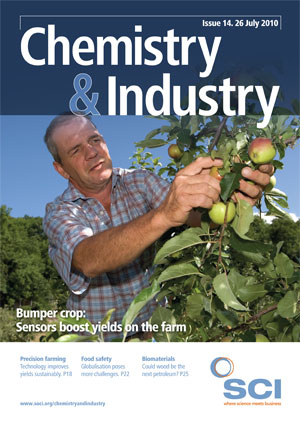Emerging sensor technologies promise to help farmers manage their crops remotely, raising yields while at the same time reducing chemical inputs, reports Cath O’Driscoll
Bruce Grieve has a vision of what a future farm might look like that many others might dismiss as ‘science fiction’. In the farm of the future, says the director of the Syngenta Sensors University Innovation Centre (SUIC) in Manchester, UK, arrays of sensor networks will be buried below the soil monitoring local conditions and remotely sending back that information to help the farmer better manage his crop: when and where to apply fertiliser or crop protection chemicals, whether to water and even if the crop is ready to harvest.
Uptake of nutrients and water in the plant roots
But Grieve’s vision is much more than a mere pipedream. At SUIC, researchers have already built just such a sensor device capable of monitoring and recording the uptake of nutrients and water in the plant roots. ‘The idea is analogous to the old iceberg principle that says 10% of the berg is above water while 90% is below,’ Grieve says. ‘The bit that’s really important for plants is the roots – where the plant draws water and nutrients.’
The group’s sensor technology took its inspiration from the process called tomography that is used in monitoring chemical manufacturing processes and for body imaging in hospitals. In this case, it records pictures of how things move around in soil, which is ‘a very complex particulate filter,’ he explains. ‘They’re not beautiful high definition images – more what we call “blobology” – but they give us an idea of what’s shifting around: the way plants draw moisture and interact with soil nutrients.’
While general field applications are still be some way off, the sensor is already being trialled for high throughput screening applications to identify new crop varieties for future breeding programmes. A plant’s root structure is also closely related to its genotype – and hence its physical characteristics, Grieve says – so picking out these important traits by looking at a plant’s roots should make this process faster and less subjective. The associated genotyping and soil science work are being carried out by researchers at the University of Nottingham’s Centre for Plant Integrative Biology (CPIB) in the UK.
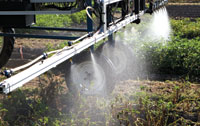
Optical sensors for determining a plant’s nitrogen status are among the most successful of the current cohort of precision agriculture tools and have been around for over a decade. They work by measuring changes in light reflectance from the growing crop canopy. ‘The greenness of the plant determines how healthy it is against a field average or industry benchmark,’ Beecher Jones explains; this in turns indicates the amount of nitrogen the plant has taken up through its roots, which is important for crop growth and for producing valuable grain. Knowing how much nitrogen is in the plant allows farmers to decide when, where and how much fertiliser to apply, which not only helps to reduce costs and improve crop productivity, but also minimises agrochemical runoff, which is a problem for surrounding rivers and streams.
Fertiliser company Yara currently has 220 nitrogen sensor units in the UK, according to precision agriculture consultant Clive Blacker. ‘These are used to measure nitrogen uptake of the arable crop and have calibrations for many different crops [, which] result in the correct application of nitrogen to a canopy without over-fertilisation,’ he explains: ‘Yara trials have proven that farmers will see a 3.5% improvement in yield using the same amount of fertiliser but just applying it where it is needed.’ Other claimed benefits include a reduction in ‘lodging’ or bending of the crop plants, more grain proteins and an improvement in crop harvestability by up to 26%.
This variability of nitrogen and other nutrient levels– stemming from the underlying variability in soils – poses a big challenge for farmers seeking to optimise crop productivity. Soil nitrogen levels, for example, can vary by a factor of two or three even for soil samples only a few centimetres apart, which can have a dramatic affect on plant vigour and health. Farmers have traditionally measured this variability – along with those of other elements such as phosphorus and potassium – in soils by taking samples at regular intervals and sending them away for analysis – a method that is not only time consuming and laborious, but which also covers only a fraction of the sampling area available to optical sensors.
Soil sampling
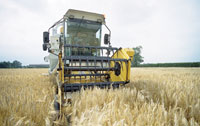
Rothamsted colleague Jon West, meanwhile, is more interested in extending the applications of optical sensors beyond nitrogen sensing - for the early detection of important crop diseases. Many fungal diseases such as rusts often spread by the dispersal of spores from an original loci – leading to patches of disease around a particular crop area. However, faster computer speeds and advances in agricultural machinery now hold out the prospect of ‘Precision Pest Management’, West says.
In a new book to be published on Precision Crop Protection later in 2010, West and coauthors point out that using such sensors alongside spatially directed crop sprays could remove these early disease loci – so avoiding the need for farmers to ‘chase the disease’ through the growing season and reducing the amount of chemical sprayed, in turn lowering residue levels in food and water.
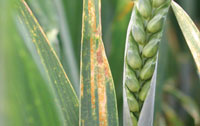
The technology is likely to be most valuable for certain high value crops where the technology investment makes most economic sense, West says. For indoor or protected crops, sensors could be moved around the crop on a system of cables to scout for diseases and other stresses. Similar technology, for example, could also potentially be applied for weed control, Beecher Jones points out.
West is also collaborating with SUIC’s Grieve, meanwhile, on a separate air sensor project, SYield – sensors for protecting crop yields – to detect chemical or biochemical changes that provide an early warning signal of crop pathogen attack. The pair have just received funding from the UK Technology Strategy Board for a project beginning later in 2010 to develop a biosensor to detect pathogens such as fungal spores directly on site; knowledge that would prepare farmers for an invasion even before any damage has begun. The details are still sketchy, but West says that the work is directed at a less publicised aspect of precision agriculture – not just where a pathogen has landed, but when it will arrive – information that will allow farmers to better decide the timing of when to deliver crop protection.
‘The use of air sensors for disease detection is relatively new,’ West says. ‘In Canada, farmers use such sensors to look for grapevine disease and can get DNA samples analysed by polymerase chain reaction (PCR) the same day they are sent but this is a niche high value crop. Usually, samples need to be sent away to a lab and tested and the results are sent back to the farmer a day or two later.’
The new biosensor will work by picking up some chemical change or antibody binding event, which would result in a change in electrical conductivity or colour that could be immediately picked up by the farmer, West explains. It will be especially useful for fungal or other diseases that appear infrequently every few years, he says; examples include fusarium that affects wheat or sclerotinia in oilseed rape, peas, beans and carrots.
Yet other sensor technology already under development at SUIC promises to help farmers at the other end of the supply chain, during shipment of food and other produce ready for sale by retailers. A staggering amount of produce is lost during transportation, particularly in developing countries, such as in Africa, where more than 10% of food perishes before it ever reaches supermarket shelves. Data loggers are occasionally used on selected cargoes but are expensive and can only yield information once the produce reaches its final destination, preventing the possibility of remedial action to preserve the produce en route.
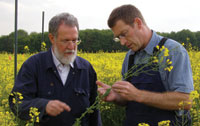
And as well as foods, the sensor should be useful for transporting other goods, such as flowers. ‘Cut roses have a very short shelf life of around 72 hrs’, Grieve points out. ‘They should be kept chilled at 3-5C during transport but we have seen boxes at temperatures of up to 40C, as once decay starts it generates heat.’
As for his farm of the future, Grieve believes that cheap and low energy wireless sensors such as this will one day be playing a part in almost every aspect of farming life. ‘One of the biggest gains will be to bring the best practices from farms in the West and spread them not just to others in the EU and US, but to emerging economies such as India and China,’ he says. ‘This information should allow farmers to get similar yields to those in the West no matter where they are in the globe.’
For all their usefulness, however, Beecher Jones emphasises that sensor technologies will never replace farmers. ‘They will improve the farmer’s ability to extract information from crop,’ he says, ‘but they won’t take away the decision making from him as that’s mainly concerned with the weather’. And that’s something that nobody is able to accurately predict.
Water, water, but not everywhere
Supplying the world with food demands a lot of water. Agriculture consumes about 70% of fresh water worldwide, with around 1000L required to produce 1kg of cereal grain and 43,000 L to produce 1kg of beef (Bioscience, doi:10.1641/0006-3568(2004)054[0909:WRAAEI]2.0.CO;2). However, new sensing technologies promise to help farmers gauge water levels in soil more accurately, helping to protect and conserve supplies at the same time as boosting crop yields.
Current technologies for monitoring soil water content measure either the volume of water in soils or the matric potential that results from the forces between water and the surrounding soil particles. ‘The advantage of the latter is that it measures the very force that the plant will have to exert in order to pull water from the soil,’ says Richard Whalley, a water sensor expert at the UK’s Rothamsted Research.
Sensors that measure matric potential are applicable for all soil types as they indicate how easily a plant draws water from soil, unlike volumetric sensors, which only show how much water is present, not all of which may be available to the plant, says Dick Jenkins, sales manager at instrument manufacturer Delta-T Devices. Whalley and Delta-T are collaborating on a new sensor device for measuring matric potential that aims to overcome some of the limitations of conventional water-filled tensiometers. The new device is still at prototype stage, but Jenkins says it should be available in the next year or two at similar cost – a few hundred pounds – to the old system. And whereas current tensiometers only read from 0 to -80kPa, the new one can measure matric potentials in much drier soils, from 0 to -300 or even - 400 kPa, he adds. Matric potential is negative in unsaturated soils; in saturated soil the water pressure is positive and referred to as the hydrostatic pressure.
‘Not many farmers want to use a water-filled tensiometer as it’s fairly impractical,’ Jenkins says. ‘If it doesn’t rain and the soil gets too dry, the water column breaks and the farmer has to fill it up again. With the new device that’s not a problem; if it dries out too far it may not show a reading but it still works.’
Conventional tensiometers measure the pressure in a water column linked to a porous water-filled ceramic cup placed in the soil. However, they are notoriously unreliable, particularly for drier soils where it can often be impossible to obtain a reading due to breaks in the water column and in cold climates when the column may sometimes freeze.
The new device replaces the water column with a dielectric sensor: a printed circuit board (PCB) sandwiched between two porous, initially water soaked, ceramic blocks. It provides an electrical readout that can be readily converted to the matric potential. While it probably won’t replace other water sensing devices for all applications, Whalley says it should be especially useful for irrigation control and for monitoring the matric potential in the plant root zone during drought, where there is a need for accurate sensors with a wide measurement range.

